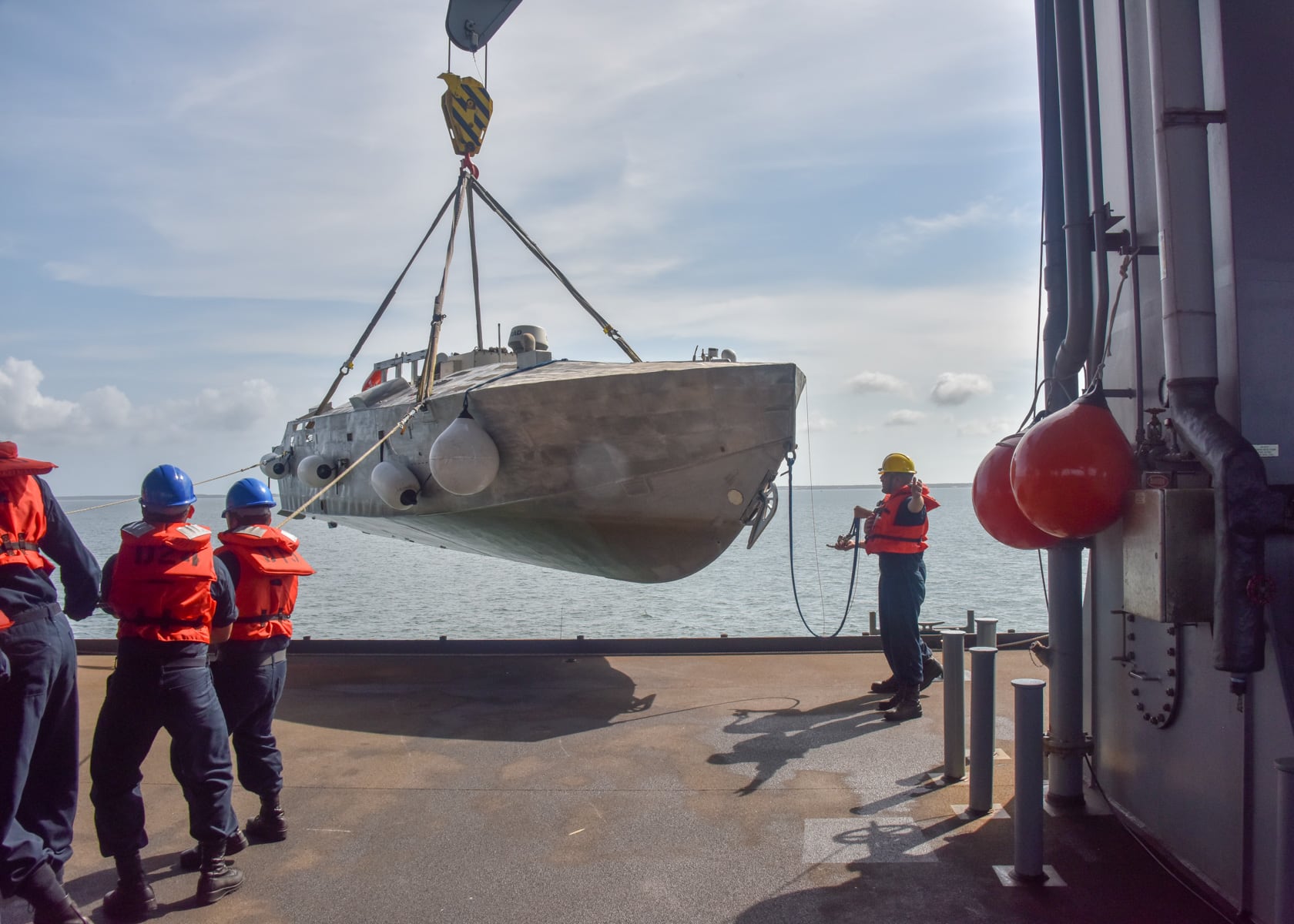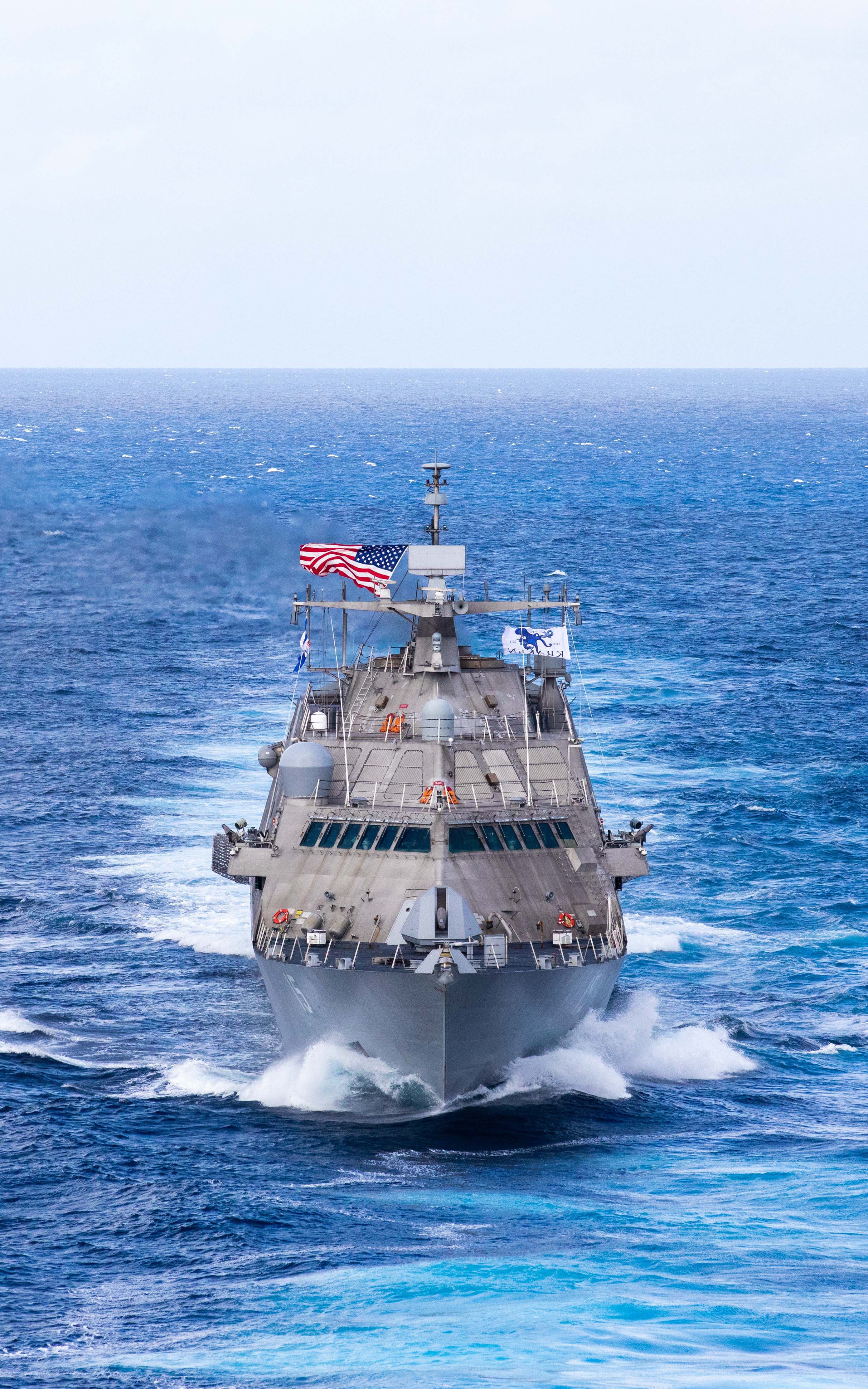WASHINGTON — It’s been called an “entirely new breed of U.S. Navy warship” and a “lemon.” A “mothership” for unmanned systems and “the wrong ship at the wrong time.” A cornerstone of the Navy’s “transformation” and the “little crappy ship.”
This is the littoral combat ship, which in its 22-year history has never been easy to label. That is until recently; the LCS has now become an enormous sunk cost.
The Navy is decommissioning nine of 35 littoral combat ships in the next few years, alongside the five already abandoned. Some, like the recently retired LCS Sioux City, entered service less than five years ago.
Decommissioning these ships early amounts to a loss of almost $7 billion based on analysis by Defense News using data from the Congressional Budget Office. But experts say the opportunity cost is more significant as the Pentagon prepares for a potential war with China, which in the last 20 years has built extensive anti-access, area denial defenses to keep ships like the LCS away from its shores.
“[These] ships were built for a world that no longer exists,” said Jerry Hendrix, a retired Navy captain and former Pentagon official, who is now a senior fellow with the Sagamore Institute think tank.
It’s a moment of irony for the Navy: decommissioning young ships while trying to expand its fleet. The LCS, analysts and former Pentagon officials told Defense News, was designed to be the Navy’s ship of the future. But in the process, it became a program meant to do too much, too soon, and at too low a price tag to succeed.
“Decommissioning them is a terrible decision,” said Bryan McGrath, a former naval officer and lead author of the Navy’s 2007 strategy document, who is now managing director of The FerryBridge Group defense consultancy. “But the only decision worse than that would be keeping them.”
‘Pedal to the metal’
In 2001, the Navy had a numbers problem. In the previous decade, following the end of the Cold War, the service had retired more than 200 active ships. A further 50 destroyers and frigates were set to retire, starting in 2005.
New ships were under development, including the Zumwalt-class destroyer and Ford-class aircraft carrier. But these large-scale combatants were too expensive to replace the outgoing ships one for one. The Navy needed a small combatant, cheap enough to build in mass and nimble enough for lower-level missions.
Indeed, the Office of the Secretary of Defense told the Navy there would be no Zumwalt without plans for a small combatant, which would need to cost a third of one Arleigh Burke-class destroyer — or around $400 million.
The LCS was designed to be just that ship. But from the start, the program served two masters: On one hand, it was meant to fill a demonstrated need; on the other, it became a catchall for the Pentagon’s new initiatives.
“It was just born in a way that was almost guaranteed to fail,” said Bryan Clark, director of the Center for Defense Concepts and Technology at the Hudson Institute think tank.
Before becoming defense secretary in 2001, Donald Rumsfeld had spent years arguing the Pentagon needed “transformation,” or as he said in 2002, “to behave somewhat less like bureaucrats and more like venture capitalists.”
This ship would test that model.
First was the concept. The Navy had identified three missions suited for a small combatant: anti-submarine warfare, surface warfare and minesweeping. Rather than build three ships, or even three different hulls, Chief of Naval Operations Adm. Vern Clark pushed for one. (Clark served as CNO from 2000 to 2005.)

It would have a single “seaframe” with modular “mission packages” that could be swapped out depending on the need — like a Swiss Army knife.
“The idea [for the ship] was rather radical at the time,” said Bob Work, who served as deputy defense secretary and undersecretary of the Navy during the Obama administration. “What people don’t remember is this is something the Navy had never done before.”
To lower personnel costs, the ship would have a condensed crew — less than 90 members compared to the 200 or so for a frigate. Hence, its sailors would need to be highly trained and make greater use of unmanned systems, which soon became a priority for the Navy as the Air Force began using Predator and Reaper drones in the Middle East.
“Nobody wanted to say no [to these requirements] because this was an example of transformation,” said Clark of the Hudson Institute.
The second hallmark was the program’s speed. The LCS skirted the usual process for vetting a new ship, instead taking a path later referred to by a budget expert as an “analytical virgin birth.” Congress funded the Navy’s budget request for the ship in 2003 while warning that the service lacked a “road map.”
From there, the LCS moved quickly. The first model entered service in 2008, three or four years ahead of the Pentagon’s usual acquisition pace.
“We made the decision to put the pedal to the metal all at once,” Hendrix said.
Problems and price tags
The program had three core goals: to be high tech, low cost and fast paced. But its aims were too high.
“What went wrong was the Navy couldn’t get the mission packages to work,” said Work.
There were engineering snags. The submarine warfare package, intended to detect and attack submarines in shallow waters, needed a sonar hitched to the back of the ship, but it wasn’t trailing correctly. The minesweeping package, designed to clear mines with unmanned systems, began hitting delays.
Compounding these flaws were problems with the hulls. Some experienced transmission issues, and others began to crack at high speeds — a problem since moving quickly was a priority for the ship.
The modular design — in which users could rotate equipment — was also proving impractical in terms of transporting the packages and quickly installing them. Furthermore, the specialized crews required for each mission drifted between ships, unable to gel with their vessel or their fellow sailors.
“Ultimately [the model requires] very senior crews that are stuck on these not-very-capable ships,” a Democratic aide with the House Armed Services Committee told Defense News on the condition of anonymity to speak candidly.
These issues increased costs, but the extent of those overruns wasn’t immediately clear. Despite its technical problems, the LCS was still considered for years a low-cost way to expand the fleet.
To achieve this, Congress initially encouraged the Navy to have two companies develop models, and then pick one. Those companies — General Dynamics and Lockheed Martin — competed so aggressively that their advertised costs came in low enough it seemed possible to buy both. Congress approved block-buy contracts for 22 ships, starting in 2010.

Adm. Vern Clark, the top Navy officer at the time, had initially hoped each ship would cost $250 million, or five for every one Arleigh Burke destroyer. But with engineering woes and program delays, prices began to rise. In 2016, after persistent engine problems, the Navy ordered a 60-day review of the program, which recommended a host of technical and personnel changes.
However, the engineering problems didn’t stop. In 2022, the Navy dropped its plan for an anti-submarine warfare mission package. By then, the service had already started decommissioning several of the first LCSs built, which hadn’t received any upgrades since construction and were projected to cost $2.5 billion to update.
According to the Congressional Budget Office, each ship cost about $500 million — some more than $600 million — after factoring in the mission packages.
“I don’t think we’re going to be decommissioning many that are all sunshine, no rain clouds,” said Mark Montgomery, a retired Navy rear admiral and a senior fellow at the Foundation for Defense of Democracies think tank. “I’m pretty confident that we’re decommissioning things that are maintenance burdens.”
The new small combatant
In spring 2022, the Navy announced a plan to decommission nine LCSs in the coming years because they wouldn’t help the service in a potential fight against China, which is among the Biden administration’s priorities for military planning.
Analysts and former Pentagon officials interviewed by Defense News largely agreed with that assessment, though some questioned whether it’s the best way to judge the fleet.
Under the Biden administration, “my impression of the way the Navy responds to its political tasking is that if your widget, your ship, your platform does not directly contribute to the fight with China, it is in jeopardy,” said McGrath, the former naval officer. But he noted the Navy also has peacetime missions and requires a mix of high- and low-end systems to accomplish its different goals.
“We spend most of our time not being shot at,” he said.
Others said they felt frustrated at seeing the ships abandoned so soon, given the Navy reported to Congress last year that the LCS was at last “on trend to meet design requirements for the [minesweeping] and [surface warfare] missions as they were established.”
This March, more than 20 years after the LCS program began, the minesweeping mission package reached initial operating capability. That marks two of the program’s three main successes, said Clark of the Hudson Institute.
The mine-clearing mission package is the world’s first to entirely use unmanned vehicles to neutralize minefields, he said. In addition, most of the Independence-class LCSs, whose design was less afflicted by engineering issues than the Freedom class, will remain in service.
The other success is the industrial capacity the program protected, according to Hendrix. By keeping two shipyards open, he said, the Navy maintained skilled workers. For example, the Marinette Marine shipyard in Wisconsin, which produced the rapidly decommissioning Freedom-class LCS, is now building the Constellation-class frigate, the Navy’s new small combatant.
This frigate has in some ways benefited from the failures of the LCS program. Its multimission design makes it capable of air warfare, surface warfare and anti-submarine warfare, but without needing to attach or detach equipment, like the LCS.
In some ways, accepting the littoral combat ships as a sunk cost will save money, experts said. The operating costs for each one are around $70 million each year, said Mackenzie Eaglen of the American Enterprise Institute think tank. Operating and support costs end up being about 70% of the total price tag for a ship’s expected life span.
Better to discard systems with little utility than to keep wasting money on them, said Rep. Adam Smith, D-Wash., the ranking member of the House Armed Services Committee.
“The lesson that LCS has proved is that if a ship doesn’t provide capable and relevant warfighting ability, it doesn’t matter what capacity they provide,” he told Defense News.
Keeping up with threats
Operating costs aside, the LCS program is still largely defined by its delays and waste.
Defense News estimates the value of lost service life at $7 billion by dividing the cost of each LCS seaframe (in 2023 dollars) by its intended service life of 25 years, and then multiplying out the cost of each unused year.
For example, a ship that cost $500 million and was intended to sail for 25 years should cost $20 million per year — plus operating costs, which were saved. But if it only served for five, it left 20 years — and hence $400 million worth of intended service life — dormant.
Still, the most significant waste for the LCS program may be a lost opportunity, Hendrix said. The time and resources spent building these ships could have gone toward building more capable and better-suited vessels for today’s threats.
Certainly the three missions of the LCS focused on countering anti-access, area denial capabilities, but that technology from the early 2000s has since advanced, rendering the LCS nearly useless against China.
Years before the program began, in 1996, the U.S. sailed a carrier strike group through the Taiwan Strait as a warning to China, which considers the island nation a rogue province. It angered Chinese leadership, who began working on missile defense systems with a range farther off its coast.
This took place around the same time the U.S. Navy was preparing for a “brown water” fleet, which would operate closer to land, said Eaglen. The LCS was one of several systems designed for such environments and perhaps the clearest example of that thinking’s obsolescence.
Now, given China’s defenses, the Navy no longer has the same freedom to operate in littoral environments — at least in a hypothetical war over Taiwan. A generation of U.S. Navy programs, argued Hendrix, were designed for the wrong challenges.
“We zigged and the world zagged,” he said.
The Navy isn’t the only service that failed to prepare for today’s threats. After 20 years mired in the Middle East, rather than preparing for an ascendant China, former Pentagon officials rue a missed opportunity. The services have since pivoted to intense competition with the Asian nation, but for the U.S. Navy, that came after it started buying the LCS. This left the service with a slew of ships it considers strategically irrelevant for its “pacing challenge.”
Technical issues aside, the Navy’s ship of the future couldn’t survive the challenges of the future.
“It’s a shame that we came to this realization after we bought all the ships,” the congressional aide said. “But I guess better late than never.”
Noah Robertson is the Pentagon reporter at Defense News. He previously covered national security for the Christian Science Monitor. He holds a bachelor’s degree in English and government from the College of William & Mary in his hometown of Williamsburg, Virginia.





